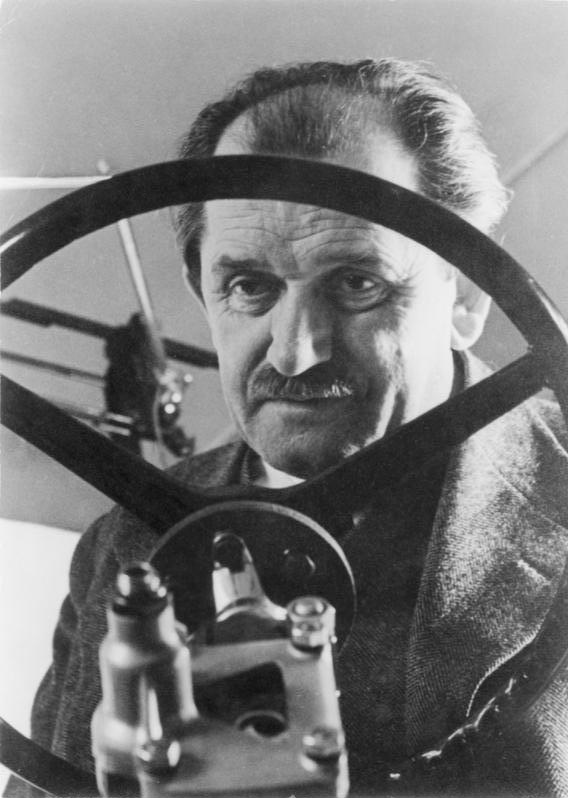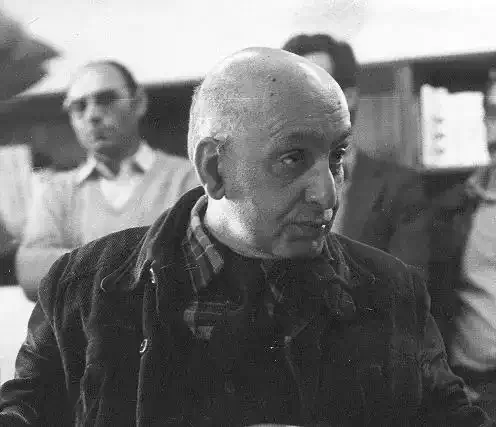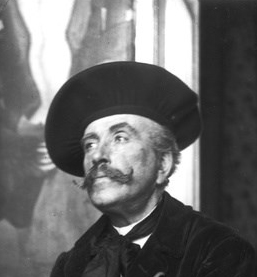Alan Christie Wilson (Arlington, Massachusetts, July 4, 1943 – Topanga, California, September 3, 1970), nicknamed "Blind Owl", was an American musician, best known as the co-founder, leader, co-lead singer, and primary composer of the blues band Canned Heat. He sang and played harmonica and guitar with the group live and on recordings. Wilson was the lead singer for the group's two biggest U.S. hit singles: "On the Road Again" and "Going Up the Country".
Early years
Alan Christie Wilson was born to John (Jack) Wilson (1914–2000), a bricklayer, and Shirley Bingham (1922–2011), an artist on July 4, 1943, and grew up in the Boston suburb of Arlington, Massachusetts. He had an older sister Darrell and was of English, Scottish, and German descent. His parents divorced when he was 3 and both later remarried. Wilson was highly intelligent, setting him apart from his peers. As a result, he was often bullied by his schoolmates. His father Jack enjoyed ham radio operation. Alan became involved as a child but soon turned his interest to music after his stepmother Barbara bought him a jazz record. Some of Wilson's first efforts at performing music publicly came during his teen years when he learned trombone, teaching himself the instrumental parts from the aforementioned jazz record. Later he formed a jazz ensemble with other musically oriented friends from school called Crescent City Hot Five.
Wilson was into traditional New Orleans music, and later, classical European and Indian music. He was also on the high school tennis team. Eventually, Wilson quit trombone. Around the same time Wilson developed a fascination with blues music after a friend played a Muddy Waters record for him, The Best of Muddy Waters. Inspired by Little Walter, he took up harmonica, and soon after the acoustic guitar after hearing a John Lee Hooker record. Some of Wilson's other major influences included Skip James, Robert Johnson, Son House, Charley Patton, Tommy Johnson, John Lee Hooker, Muddy Waters, and Bukka White. After graduating from Arlington High School in 1961, he majored in music at Boston University. His academics earned him a National Merit Scholarship and the F.E. Thompson Scholarship Fund from the Town of Arlington. Wilson developed into a dedicated student of early blues, writing a number of articles for the Broadside of Boston newspaper and the folk-revival magazine Little Sandy Review, including a piece on bluesman Robert Pete Williams. Anxious to play music rather than study it, Wilson quit school after only a year and a half. To make ends meet, Wilson worked with his father as a bricklayer, and occasionally gave harmonica and guitar lessons.
Career
In 1962, Wilson met Harvard student and fellow blues enthusiast David Evans in a record store, and the two began playing as a team around the Cambridge coffeehouse folk-blues circuit, with Evans on vocals and guitar, Wilson on harmonica and occasionally second guitar. The two played a repertoire of mostly classic-era blues covers. Heavily influenced by Skip James, eventually Wilson began singing in a way similar way to James' high pitch. In high school, Wilson studied James' 1931 recordings with great ardor. Some of his first singing attempts took place behind a closed bedroom door; and when a family member overheard him, he was embarrassed. Wilson eventually perfected the high tenor for which he would become known.
The early 1960s saw a "rediscovery" of pre-war blues artists by young, white blues enthusiasts, including Mississippi John Hurt, Booker White, Skip James and Son House. In 1964, blues enthusiast Tom Hoskins located John Hurt, who at the time had been working on a local farm in his native Mississippi. Hoskins persuaded Hurt to come north to Cambridge for a gig. Wilson was invited to accompany Hurt on harmonica. Said Hoskins, "He was brilliant."
Son House, considered by Wilson to be one of the most impressive harmonica players in blues history, was located in Rochester, NY in 1964, but it was evident that House had forgotten his songs due to his long absence from music. Wilson played House's old recordings from 1930 and 1943 for him. and demonstrated them on guitar to revive House's memory. House recorded Father of Folk Blues for Columbia Records in 1965. Two of the selections on the set featured Wilson on harmonica and guitar. In a letter to Jazz Journal published in the September 1965 issue, Son House's manager Dick Waterman remarked the following about the project, and Wilson:
- It is a solo album, except for backing on two cuts by a 21-year-old White boy from Cambridge by the name of Al Wilson. Al plays second guitar on "Empire State Express" and harp on "Levee Camp Moan." Al never recorded before, but he has backed John Hurt, Skip James, Sleepy John Estes, Bukka White and many others. He is good, and the record will prove it.
- Al Wilson taught Son House how to play Son House. I can tell you, flatly, that without Al invigorating and revitalizing Son, there would have been no Son House rediscovery. All of Son’s successful concert appearances, recordings and him being remembered as having a great second career — all that was because of Al rejuvenating his music.
Canned Heat
During his time performing in Cambridge, Wilson met American guitarist John Fahey, the "Father of American Primitive Guitar." With Fahey's encouragement, Wilson moved with Fahey to Los Angeles in 1965 with the aim of having Wilson assist with his UCLA master's thesis on Charley Patton. Because Wilson forgot his glasses during the trip, Fahey gave him the nickname "Blind Owl" owing to his extreme nearsightedness, roundish facial features and scholarly nature. In one instance when he was playing at a wedding, he laid his guitar on the wedding cake because he did not see it. As Canned Heat's drummer Fito de la Parra wrote in his book: "Without the glasses, Alan literally could not recognize the people he played with at two feet, that's how blind the 'Blind Owl' was."
Once in Los Angeles, Fahey released The Transfiguration of Blind Joe Death. Wilson provided the liner notes under the pseudonym Charles Holloway, Esq. In 1966, Wilson recorded a series of traditional Indian ragas on Fahey's Takoma label but was never issued. Four of Wilson's ragas later appeared as the nine-part soundscape "Pathenogenesis" on Canned Heat's third album, Living the Blues. A portion of "Raga Kafi" is performed on the chromatic harmonica. Fahey's 1992 album Old Girlfriends and Other Horrible Memories features more of "Raga Kafi" in "Fear & Loathing at 4th & Butternut," although Wilson was not credited.[11] In Los Angeles Wilson met fellow blues enthusiast and record collector, Bob "The Bear" Hite at a record store. Together they founded Canned Heat in 1965. The band's name was taken from Tommy Johnson's 1928 song "Canned Heat Blues," about an alcoholic who turned to drinking the cooking fuel Sterno. Originally beginning as a jug band, Canned Heat initially consisted of Hite on vocals, Wilson on bottleneck guitar, Mike Perlowin on lead guitar, Stu Brotman on bass and Keith Sawyer on drums. The group landed gigs at the Ash Grove in Hollywood, and after Perlowin dropped out, Hite invited his friend Henry "The Sunflower" Vestine, from Frank Zappa's Mothers of Invention to join on guitar. Johnny Otis produced the group's first full-length album in 1966. It featured Hite, Wilson, Vestine, Brotman, and new drummer Frank Cook in his studio just off Vine Street in Los Angeles. The record was not released until 1970; and Vintage, as it was titled, has since become the most re-packaged and bootlegged record in Canned Heat's discography. Over a Summer hiatus, Brotman left Canned Heat and was replaced by Larry "The Mole" Taylor, an experienced session musician who played with Jerry Lee Lewis and The Monkees.
Canned Heat's first year was marked by infrequent gigs and public indifference. Wilson later told Melody Maker, “The first year we were together, we worked for three weeks. We’d get a gig, play three days and get fired … because we refused to be a human jukebox.” After a particularly disastrous engagement the group disbanded in August 1966. During this period, Wilson and Vestine moved on to join the Electric Beavers, an ensemble featuring a full horn section. The band lasted for a short time on a rehearsal basis only. Eventually, Canned Heat re-formed in November 1966. During a gig at the Ash Grove, Canned Heat earned the attention of singer/songwriter Jackie DeShannon, who was married to the head of A&R at Liberty Records, Bud Dain.
The band released their first album, Canned Heat, featuring reworkings of older blues songs for Liberty Records in July 1967. Their first big live performance was at the Monterey Pop Festival on June 17, 1967, where they performed renditions of "Rollin and Tumblin," "Bullfrog Blues," and "Dust My Broom." Downbeat Magazine praised the band's performance: “Technically, Vestine and Wilson are quite possibly the best two-guitar team in the world and Wilson has certainly become our finest white blues harmonica man." Wilson wrote and sang the band's break out hit "On the Road Again," an updated version of a 1950s composition by Floyd Jones, on the band's second release, Boogie with Canned Heat. In an interview with Downbeat Magazine he remarked, "...on 'On the Road Again' I appear in six different capacities – three tamboura parts, harmonica, vocal, and guitar, all recorded at different times." "On the Road Again" peaked at number 16 on the Billboard Hot 100, and at number 8 on the Uk singles charts earning the band immense popularity in Europe. Drummer Frank Cook left the band in December 1967 and was replaced by Adolfo "Fito" de la Parra. Canned Heat's third album included the band's best-known song, also sung by Wilson, "Going Up the Country." The song, an incarnation of Henry Thomas' "Bull-Doze Blues" was rewritten by Wilson and caught the "back to nature" attitude of the late 1960s. The tune was a hit in numerous countries around the world, peaking at number 11 in the US. The "rural hippie anthem" became the unofficial theme song for the Woodstock Festival where Canned Heat performed at sunset on August 16, 1969. Although Canned Heat's live performance was cut from the original theatrical release of the Woodstock film, they were featured in the 25th anniversary "Director's Cut." The studio version of "Going Up the Country" was featured in the Woodstock film; and in recent years has been heard in television commercials for Geico Insurance, Subaru, and Pepsi. Around this time, Wilson became disillusioned with Canned Heat and considered quitting on several occasions. Upset over Vestine's departure and becoming more averse to touring, Wilson expressed the possibility of still recording but not touring with the band. Wilson arranged to join Vestine's new band Sunn, and Frank Cook's group Pacific Gas and Electric, however both options fell through. Eventually Wilson ended up quitting Canned Heat for about 2 weeks in late 1969, and again shortly before his death in 1970. But each time, he felt guilty and decided to go on tour again. His increasing isolation became obvious, as footage of the band at this time showed Wilson standing apart from his bandmates, and often hiding behind rows of amps.[16]
Canned Heat's fifth album, Future Blues was released in August 1970 and featured the Wilbert Harrison cover of "Let's Work Together." It became their biggest hit in the UK, reaching number 2 on the Singles Chart for 15 weeks. The cover features the band dressed as astronauts on the Moon, mocking the flag raising at Iwo Jima. The upside-down American flag was Wilson's idea in response to the country's social distress at the time, and his concern over the Moon landing a year before. However, retailers like Sears and K-Mart found the cover offensive and refused to stock the album.
In May 1970, Canned Heat teamed up with John Lee Hooker, fulfilling a dream for Wilson of recording with one of his musical idols. It would be his last recording. The resulting double album Hooker 'N' Heat was the first in Hooker's career to make the charts. On the album, Hooker is heard wondering how Wilson was capable of following his guitar playing so well. Hooker was known to be a difficult performer to accompany, partly because of his disregard of song form, yet Wilson seemed to have no trouble at all following him on this album. Hooker states that "you [Wilson] musta been listenin' to my records all your life" and also stated that Wilson was the "greatest harmonica player ever." Released after Wilson's death, the album cover features a framed photo of Wilson on the wall behind the rest of Canned Heat.
On a night off in Britain on June 30, 1970, Wilson went to see his old friend Son House, who was performing at the 100 Club in London. He sat in for “Between Midnight and Day” and “I Want to Go Home on the Morning Train." The show was recorded and originally released as John The Revelator on Liberty in 1970. The session was a concept album with House narrating through his last European performance in a biblical format. It was reissued in 1995 with extensive liner notes by David Evans as Delta Blues and Spirituals on Capitol Records and was posthumously dedicated to Wilson.
The last live footage of Wilson was taken at Canned Heat's performance at the Kralingen Music Festival, Rotterdam, Netherlands on June 26, 1970.
Wilson appeared with Canned Heat performing "One Kind Favor" during a party scene in the drama The Naked Zoo released in 1971.
Personal life
Wilson suffered from anxiety and depression, rooted in his personal issues and in his despair over the environment. According to some, he had a couple of suicide attempts. Some sources say he never actually said he tried to commit suicide and these were simply assumptions some who knew him made after his death. As a child, Wilson experienced sleep paralysis, but later suffered from insomnia as an adult. To resolve his insomnia, Wilson started using the barbiturates Secobarbital, or "reds" as they were known on the street. He had a nervous habit of pulling and twisting his hair. In the summer of 1969, Wilson was hospitalized for depression. During this time, he wrote the song "Poor Moon," expressing his concern for pollution from the Moon landing that same year. In order to be released, however, Wilson was placed under Bob Hite's care in a legal custody agreement. Wilson was hospitalized again in the spring of 1970, as Canned Heat was scheduled to record an album with John Lee Hooker. Wilson reportedly attempted to drive his car off a freeway in Los Angeles, sustaining an injury to the top of his head. There are conflicting stories of this as some say it was an accident due to his poor eyesight and lack of driving experience. Wilson was permitted to attend recording sessions, but would return to the hospital at the conclusion of each session. His song "Human Condition," reflects an encounter with his psychiatrist at one of his hospital stays. Because Wilson was highly sensitive, introverted and struggled with social situations, some believe he was on the autism spectrum. With his talent and intellect, most dismissed him as brilliant but a little odd, as autism was not well understood at the time. There are no actual diagnoses indicating he was autistic. Others who knew him disagree that he was autistic. Some who knew him also say that he was not introverted but introspective. Despite his success, he was not very successful with women, failing to relate to them or maintain long-term relationships. However, he did have some girlfriends over the years, though these relationships did not last long.
Due to his poor vision, Wilson did not learn how to drive until 1969, when Bob Hite gave him a camper van which doubled as a home. He had no interest in purchasing a home, and whenever Canned Heat was not on tour, Wilson would go camping to Yosemite or Sequoia National Park in his van at every opportunity.
Death
On September 2, 1970, Canned Heat was scheduled to leave for Germany to begin a European tour. Partly due to the inconveniences preventing him from spending time outdoors, Wilson despised touring and travelling by plane. He often missed flights and the band would fly without him while he caught a later flight. When he missed his September 2 flight, this did not raise any alarms, and Bob Hite assumed he was doing laundry to prepare for the tour. On September 3, 1970, Wilson was found dead in his sleeping bag on the hillside behind Hite's Topanga Canyon home where he often slept. He was 27 years old. An autopsy identified his manner and cause of death as accidental acute barbiturate intoxication. Although his death is sometimes reported as a suicide, this is not clearly established as he left no note, and there were four pills left in his pants found next to his body.
Wilson's death came fourteen months after the death of Brian Jones, just two weeks before the death of Jimi Hendrix, four weeks before the death of Janis Joplin, and ten months before the death of Jim Morrison, four artists who also died at the same age. Wilson was cremated, and on September 13, 1970, a memorial service was held at Menotomy Rocks Park in his hometown of Arlington. The service was led by Reverend Wilbur Canaday who said, "We are using the sky as a roof, and the ground as a floor, because he himself used nature’s great wonders as his home.” Wilson's ashes were later scattered in Sequoia National Park amongst the redwoods he deeply loved.
Conservationism
Wilson was a passionate conservationist who loved reading books on botany and ecology. He often slept outdoors to be closer to nature, and amassed a large collection of pinecones. Wilson communicated with trees and plants better than he did with people. He believed that trees were sentient beings that could experience pain. In 1969, he wrote and recorded a song, "Poor Moon", which expressed concern over potential pollution of the Moon. His clothes were often dirty and disheveled from collecting leaf and soil samples outdoors. For this reason, Wilson avoided arrest in a drug sting in 1967, when authorities raided Canned Heat's hotel room. In 1970 Wilson established a conservation fund called Music Mountain Foundation in the Skunk Cabbage Creek area of California to purchase a grove to be added to Redwood National Park. The purpose of this organization was to raise money for the preservation of the coastal redwood, which Wilson saw increasingly endangered by pollution, and urban sprawl. Canned Heat along with their manager agreed to donate proceeds from major concerts after Wilson's death, however the donations were later misappropriated. He wrote an essay called 'Grim Harvest', expressing his concern for the logging of redwoods, which was printed as the liner notes to Future Blues. It begins, "The redwoods of California are the tallest living things on Earth, nearly the oldest, and among the most beautiful to boot." It ends with a plea to "prevent Future Blues" by making a donation to his organization.
Wilson briefly worked as an ecological consultant for the United States Forest Service in 1969. He was appointed to perform a study on how rising levels of pollution would affect plant life on Earth, and then to determine which species could survive if pollution levels continued to rise at the rates at the time. During his studies, Wilson was even credited as discovering two new species of trees in the Pacific Northwest. When Wilson finished the study, he concluded that nothing could survive.
In order to support his dream, Wilson's family purchased a "grove naming" in his memory through the Save the Redwoods League of California. The money donated to create this memorial would be used by the League to support redwood reforestation, research, education, and land acquisition of both new and old growth redwoods.
Legacy
Wilson is widely remembered as a pioneer of blues-rock during its crucial development period of the 1960s who also promoted the revival of early Delta Blues. Wilson was considered by many of his musical peers to be an expert on the blues musicians who came before him; many considered him as possessing an exceptional ability for connecting musically with the elder bluesmen. He was a gifted slide guitarist, harmonica player, songwriter and vocalist. His recording career spanned only three years. Despite this, he left behind a rich legacy of inspiration to fellow artists, music scholars, and listeners alike. Mike Bloomfield of the Paul Butterfield Blues Band introduced him to Charlie Musselwhite as “the best goddamn harp player there is. He can do things that you’ve never heard before.” Wilson's friend John Fahey has said that he was "among the most significant influences on my musicianship," and that his work "must be appreciated for its immortal, spellbinding beauty." Wilson is also noteworthy for being one of the first environmentalists during the rise of the 1960s "New Environmentalism" Movement and was highly dedicated to protecting and preserving the California redwoods.
Stephen Stills' song "Blues Man" from the album Manassas is dedicated to Wilson, along with Jimi Hendrix and Duane Allman.
in Wikipédia






















